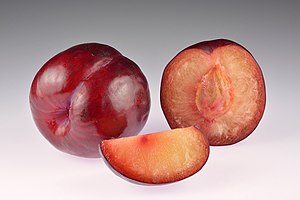Cookbook:Plum
| Plum | |
|---|---|
 | |
| Category | Fruits |
Cookbook | Recipes | Ingredients | Equipment | Techniques | Cookbook Disambiguation Pages | Ingredients | Fruit
The plum is a stone fruit related to the peach, cherry, almond, apricot, and nectarine.
Choose plums with a pleasant smell. It's common for plums to develop a yeast growth on the surface, like grapes. Plums will soften if left around, but will not gain a nice ripe taste and smell, like other fruits. They benefit more than most fruits from being picked when absolutely ripe, but before the wasps get them, and plums sold in supermarkets tend to have been picked too early, which means they suffer less damage in transit, but never develop the full taste and fragrance.
When chopped up and boiled down with sugar, plums make an excellent topping for vanilla ice cream.
Plums can also be used very effectively with duck. Try using a purée flavoured with allspice and cinnamon.
Dried plums are called prunes.
Seasonality
edit| Seasonality tables | Autumn | Winter | Spring | Summer | All year | ||||||||||||
|---|---|---|---|---|---|---|---|---|---|---|---|---|
| Plum | Jan | Feb | Mar | Apr | May | Jun | Jul | Aug | Sep | Oct | Nov | Dec |
| Northern hemisphere | ||||||||||||
| Southern hemisphere | ||||||||||||
Plums are a typical summer fruit. Early-season varieties will start halfway through May (in the northern hemisphere), whereas later season varieties will be harvested until the third week of August. Some late varieties keep well enough to last until late November. [1]